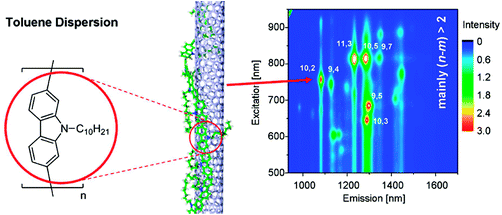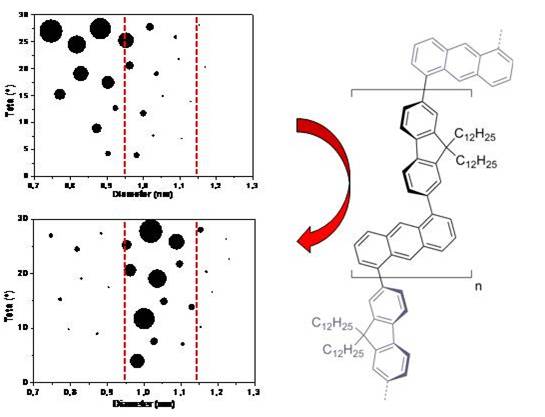C3.8: Monodisperse Synthetic Nanotubes
Subproject Leader: Marcel Mayor
Institut für Nanotechnologie, KIT
Contributing Scientists:
Present: Nicolas Berton
Past: Lijin Shu
Efficient Carbon Nanotubes Sorting is Necessary
Single-walled carbon nanotubes (SWNTs) exhibit unique physical and electronic properties which make them excellent candidates for micro- and optoelectronics as well as for nanocomposites. Nevertheless, limitations in their use arise from their non-selective synthesis providing a mixture of semi-conducting and metallic tubes with many different (n,m) chiral indices. Further purification of as-produced SWNTs is therefore required in order to obtain pure samples of either metallic or semiconducting nanotubes with specific chiral indices.
Polymer-Assisted Selective Dispersion
Various non-destructive methods of separation and purification of SWNTs have been developed recently such as dielectrophoresis, density gradient centrifugation or DNA wrapping followed by anion-exchange chromatography. However, given the technical costs and up-scaling features of these methods, the most appealing strategy would be to disperse the desired species selectively. For this purpose, noncovalent coating of SWNTs with macromolecules or polymers is a promising approach.
A few conjugated polymers, such as polyfluorene, were known to enable selective dispersion of SWNTs in organic solvents. We found recently that poly(N-decyl-2,7-carbazole) disperses exclusively semiconducting SWNTs with differences of their chiral indices (n-m) ≥ 2 in toluene [1]. Fine-tuning of the selectivity should be achieved through the combination of subunits exhibiting complementary behaviours. First experiments using strictly alternating copolymers comprising concave shaped subunits displayed promising diameter selectivity in the SWNTs dispersed by them [2]. While approaches based on molecular dynamics (MD) provide first models[1], the underlying polymer/SWNT interactions responsible for the observed selectivity are not fully understood yet.
Polymer Library
With modular building blocks we want to provide a library of various copolymers in order to investigate the correlation between polymer structure and dispersed SWNTs in details. An increased dataset will pave the way to the identification of structural features and motives dominating the polymer/SWNTs interactions which are dictating the polymers dispersion selectivity. Extending the comprehension of the polymer/SWNT interaction should allow more accurate MD calculations and thus help targeting new polymers towards single-species sorting.
SWNTs Release
In order to release SWNTs from the polymer/SWNT complex polymers having switchable dispersing features are of particular interest. Our current approach is based on photocleavable subunits in the polymer backbone. After selective dispersion the polymer can be cut into smaller pieces by light. Controlled precipitation of dispersed SWNTs was recently observed upon photoirradiation of polymers consisting of 9,9-dialkylfluorenes as a SWNT selecting template and o-nitrobenzylether as a photocleavable linker.[3]
Single Molecule Electroluminescence
Single metallic SWNTs are further very interesting electrode materials combining high electric conductivity with a low number of itinerant electrons compared with metals. While colleagues from experimental physics realized a gap of about 5 nm length in a metallic SWNT by an adapted electromigration procedure, our synthetic chemistry lab provided a tailor-made model compounds allowing first single molecule electroluminescence experiments [4]. In particular a molecular rod of 7.5 nm length comprising a central naphthalenediimide (NDI) chromophore between molecular wires with terminal polyaromatic units to increase the interaction with the nanotube surface was designed and synthesized [5]. The spectral signature of the emitting chromophore under tension in the junction corroborated the single molecule as the light source inside the junction [4]. We would like to synthesize a series of molecular rods emitting in different colors and to tune the potential required to observe light emission.
Reference
| [1] | F. Lemasson, T. Strunk, P. Gerstel, F. Hennrich, S. Lebedkin, C. Barner-Kowollik, W. Wenzel, M. M. Kappes, and M. Mayor, J. Am. Chem. Soc. 133, 652 (2011) |
| [2] | N. Berton, F. Lemasson, J. Tittmann, N. Stürzl, F. Hennrich, M. M. Kappes, and M. Mayor, Chem. Mater. 23, 2237 (2011) |
| [3] | F. Lemasson, J. Tittmann, F. Hennrich, N. Stürzl, S. Malik, M. M. Kappes, and M. Mayor, Chem. Commun., Advance Article (2011) |
| [4] | C. W. Marquardt, S. Grunder, A. Błaszczyk, S. Dehm, F. Hennrich, H. von Löhneysen, M. Mayor, and R. Krupke, Nature Nanotechnology 5, 863 (2010) |
| [5] | S. Grunder, D. Muñoz Torres, C. Marquardt, A. Błaszczyk, R. Krupke, and M. Mayor, Eur. J. Org. Chem. 478 (2011) |
List of Publications 2006-2011 as PDF
Subproject Report 2006-2010 as PDF


